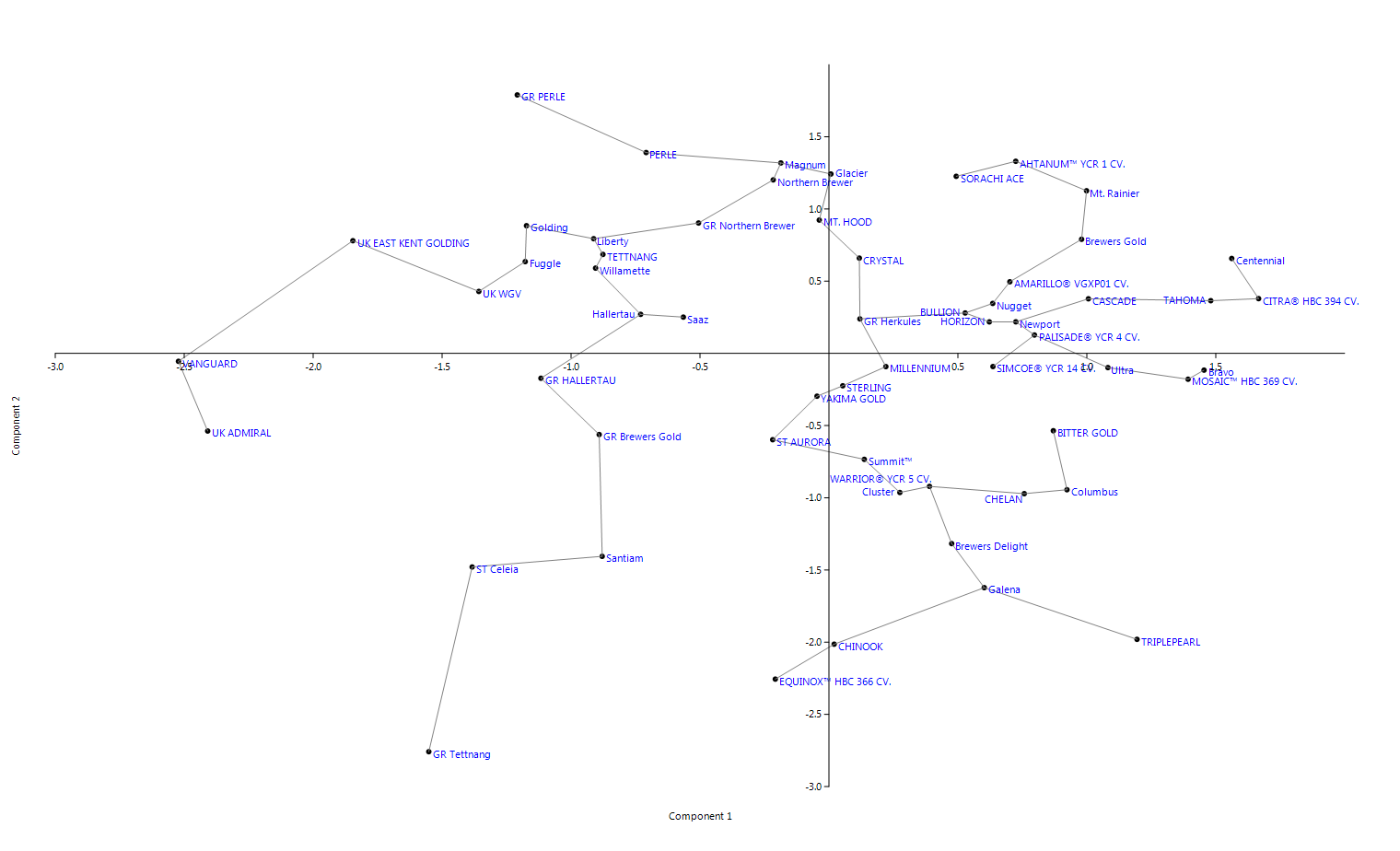Hop Replacement Calculator
Updated: 12/10/15
You might also find my Hop Oils Calculator helpful.
About the Calculator
How the calculator works
There is no shortage of hop substitution recommendation charts online, so why create another one? I wanted to take a more statistical approach to looking at hop substitutions, so I gathered all of the data I have for the 2014 hop crop sent to me by YCH HOPS and looked only at the aromatic inducing oil compounds for each hop (B-Pinene, Linalool, Myrcene, Caryophyllene, Farnesene, Humulene, Geraniol, Other). I then ran a correlation for each hops combined oil compounds against every single hop in the database, which gave me an individual numerical relationship between all of the hops.
When you select a hop in the calculator, it computes the top five closest hop varieties to your selection based on the correlation coefficient for each hop compared to your selection. The higher the number is to 1, the closer the relationship to your chosen hop (in hop oils).
I’ve also included the suggested hop substitutions from Hopunion as both a resource and for comparison purposes to evaluate the calculated substitutions. Some come as surprises and others match up to the standard substitutions we have all heard before.
Of course, this is not a perfect method for determining substitutions (I’m not sure there is one), but I think this type of calculation does get you in the ballpark for similar but not identical flavors and also provides a starting point when trying to blend certain hops to achieve desired flavors.
Using the calculator for hop blends
Another possible use for the calculator is to look at potential new hop blends. For example, can we use highly correlated hops (those with very similar oil compositions) to create interesting and reliable blends? I recently experimented with one of the calculators results that caught my eye, which was the strong relationship between Bravo and Mosaic (not something I would have guessed). The blend seemed to work, by combining similar hops in terms of oil composition you can get a more complex aroma/flavor than a single hopped beer without worrying about combining extremely conflicting flavors…well, that is the thought anyways, more experimentation is needed!
Why is the calculator missing hops?
I only used the hops that were tested at Hopunion for the 2014 harvest that they were willing to share with me. Hopefully in early 2016, I can work with Hopunion again to update the list with the 2015 harvest!
Hop Relationship Chart
You can alternatively use the image below of a principal component analysis of all of the hops which visualizes the relationship of each hop to it’s closest relative according to their individual hop oil compositions.
(click for full size) 
Other Useful Hop Links:
Hop Oils Calculator
Hop Harvest Database
Hop Harvest Database Charted
Hop Oil and Acid Rankings
Hop Oil Aroma/Taste Descriptors
Understanding Hop Pellet Blends and Oil Testing

-610x915.jpg)
In the chart above, what is Component 1 and 2?
Hello,
This chart is great. What about component 1 and 2?
Hi Please include South african hops in this calculator.Thes are made by SAB HOP FARMS.
tHANX
Principal component analysis is not terribly intuitive. Instead of attemping to explain in my own words, I will reference Wikipedia: [PCA is] “a statistical procedure that uses an orthogonal transformation to convert a set of observations of possibly correlated variables into a set of values of linearly uncorrelated variables called principal components.” If that doesn’t make sense, check out this visualization http://setosa.io/ev/principal-component-analysis/. Component 1 and 2 are never going to be as simple as myrcene and humulene oils, for example. The idea behind PCA is to reduce dimensionality, so it will be some combination of several – possibly all – factors that maximize variance in the sample. I hope that is slightly helpful.
PCA is nice & I think k-means cluster might be more interpretable, especially after overlaying the oil content for each variety with the results.
Yep! I agree with you… I think a dendrogram could be more interesting in this case… especially for dummies
Scott – I recently got my hands on about 1lb of Southern Promise hops and am debating on what to do with them. Likely either an NEIPA or a dry-hopped Pale Ale. I want to do a test batch to nail down the malt bill and hop volumes I want in the boil vs. dry-hopping. Any ideas on a suitable replacement for Southern Promise to use in my test batch?
Thanks. Love the site and looking forward to the book. Nice work!
It’s not a perfect way to try and do hop replacements, but based on the little amount of data I had on Southern Promise, it looks likes Willamette came as a close match based on oil information (all I had was Myrcene, Caryophyllene, Farnesene, and Humulene). http://scottjanish.com/wp-content/uploads/2017/09/southern-promise.png
I have noticed you don’t monetize your blog, don’t waste your traffic, you can earn extra bucks every month because
you’ve got hi quality content. If you want to
know how to make extra $$$, search for: Boorfe’s tips best adsense alternative